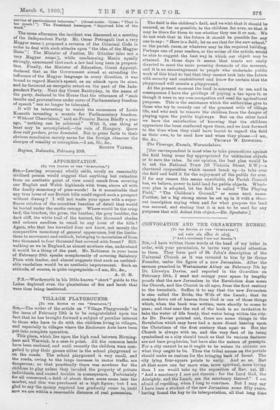CONVOCATION AND THE ORNAMENTS RUBRIC. LTC ise EIRTOR OV TIIII
spicarkToa."3 Sal ea6v mix enov iv arn.
("And a sanctuary I saw not therein.")
STR,—I have written these words at the head of my letter in order, with your permission, to invite very special attention to them. They form part of St. John's description of the Universal Church as it was revealed to him by its divine Founder, under the figure of a now Jerusalem. After the sermon preached in Westminster Abbey on February 7th by Dr. Llewelyn Davies, and reported in the Guardian on February 10th, I need not occupy your space by lengthy proofs that the new Jerusalem in the Revelation does mean the Church, and the Church in all ages, from the first century to the twentieth. Suffice it to say that the new Jerusalem is also called the Bride, the Wife of the Lamb ; that its coming down out of heaven from God is one of those things which, when the book was written, were shortly to come to pass ; and that near the end of the book is an invitation to take the water of life freely, that water being within the city. As Dr. Davies pointed out, there are some things in the Revelation which may have had a more direct bearing upon the Christians of the first century than upon us. But the Church is always with us, and the very fact of its being symbolised as a city should teach us that its various features are not bare prophecies, but have also the nature of precepts. For a city cannot be as it ought to be unless its citizens are what they ought to be. Thus the tribal names on the portals should make us zealous for the bringing back of Israel. The city lying four-square points to unity. And so on. But oh that some one far more wise, more spiritual, more loviug than I am would take up the exposition of Rev. xxi. 22: " And a sanctuary I saw not therein : for the Lord God, the Almighty, and the Lamb, are the sanctuary thereof." I an afraid of repelling, when I long to convince. But I may. say I have been a student of the new Jerusalem some fifty years, having found the key to its interpretation, all that long time
ago, in a book of F. D. Maurice's. Twenty-seven years ago I took the new Jerusalem as the main subject of my Hulsean LeCtures at Cambridge, and quoted in one of them that very verse of Blake's which Dr. Davies quoted in his Westminster sermon; a verse which, I may add, stands at the head of the first Chapter of that little book of Mr. E. Howard's which led to the founding of this•garden city where now I write :— "I will not cease from mental strife, Nor shall my sword sleep in my hand, Till we have built Jerusalem In England's green and pleasant land."
But I think it is only within the last few years, fifteen or twenty, that I have myself seen the full bearing of this " No sanctuary." In the midst of figurative language, both in ScriPtirre and out of it, we come from time to time upon words and phrases which are not figurative, but literal. Is, not this phrase literal,—" I saw no sanctuary therein,"; while the remainder of the verse, "' for the Lord God, the Almighty, and the Lamb, are the sanctuary thereof," is fig,urative 13 What figurative meaning can be reasonably assigned to that " No sanctuary," especially when we know that Christian Churches at the beginning bad no sanctuaries,—no sanctuaries made with hands, no material habitations of adorable Deity, and that Christian ministers were called, not priests, but elders I) For the true sanctuary, and the way of access to it, I may refer to the words of our Master in John xiv. 23. The Epistle ascribed to Barnabas wae.probably not written by the companion of St. Paul, and it has no authority in matter of doctrine. But it dates from the first half of the second century, and may be trusted, I suppose, as a witness to then current practices. Its sixteenth chapter is occupied with the contrast between Christians who bad no sanctuaries, and both Jews and heathen who bad
sanctuaries.—I am, Sir, &c., J. FOXLEY, Retired Rector.
6 Norton Way N., Letchworth, Hitchin.















































 Previous page
Previous page